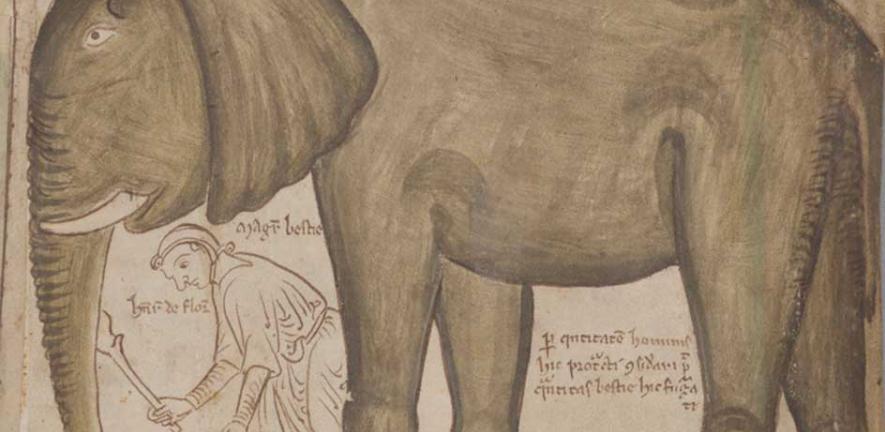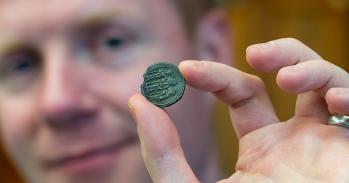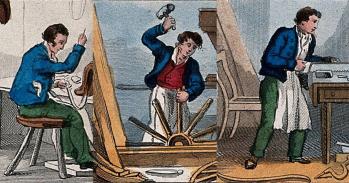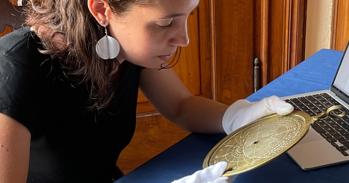
Don't miss the chance to visit one of the world's best collections of medieval manuscripts when the Parker Library welcomes visitors as part of Open Cambridge.
Don't miss the chance to visit one of the world's best collections of medieval manuscripts when the Parker Library welcomes visitors as part of Open Cambridge.
Beady-eyed dragons wriggle and writhe into the opening letters of 8th-century manuscripts, spitting Celtic patterns from their jaws which entwine the page.
A wonderful selection of beautifully-crafted medieval manuscripts will be on display when the Parker Library of Corpus Christi College reveals its magical contents for Open Cambridge on Saturday, 10 September, 10am-4pm.
Spanning the 6th to the 16th centuries, the books contained in the Parker Library are invaluable historical sources on subjects such as theology, politics, kingship and canon law, travel, mythical beasts and medieval high culture. They also represent painstaking work, each written by hand before the invention of printing, and decorated with miniature works of art featuring the fantastical and chimerical beings which captured the medieval imagination.
The Parker Library’s earliest inventory dates back to 1376; it lists just 55 books. Today, the library has more than 600 medieval manuscripts and 5,000 books. It boasts one of the most extensive collections of Anglo-Saxon books in existence, and contains a large number of the oldest books in England. This extraordinary collection was given to Corpus Christi by Matthew Parker (1504-75), whose name is honoured by the library as the supreme benefactor.
The books and manuscripts with their accompanying illustrations offer us a window into Europe in the Middle Ages – a difficult time to survive, but one partly rationalised by superstition, magic and the supernatural. Beady-eyed dragons wriggle and writhe into the opening letters of 8th-century manuscripts, spitting Celtic patterns from their jaws which entwine the page. Domesticated monsters hidden among the foliage are caged inside the ornately pillared letters of a 10th century school textbook. The lines are sharp and the colours are bright, the gold is real gold, and the colour blue was ground from lapis lazuli – a semi-precious stone prized since antiquity for its vibrancy.
One Gothic manuscript, the Peterborough Bestiary (East Anglia c.1300), is a meticulous inventory of 104 animals of the world. Creatures such as the elephant are described and drawn in detail alongside the mythical unicorn, whose existence seemed no less probable to the people of early medieval England who had never seen either animal in the flesh. Curiously, this 14th century text also adds that elephants not only have a memory of 300 years, but are frightened of mice – a fable which still exists today.
Some of the illuminations are darker in character, reminding us of the struggles and toils of a tumultuous age. The Passio Sancte Katherine (in verse, St Albans c.1300) illustrates the attempted execution of St Katherine of Alexandria, set upon four large spiked wheels. Historical chronicles such as Matthew Paris’s Chronica Maiora (St Albans, c.1250) portray the combination of brutal warfare and chivalric courtly life which dominated the medieval psyche. Swords clatter and horses rear in busy pictures of crusader battles.
The image above, from the Chronica Maiora, shows an elephant in the Tower of London, with its keeper Henry of Florence. The elephant joined the royal menagerie as a gift from Louis IX of France to Henry III of England. Tragically, it died in 1258 after mistakenly having been fed only meat, and was buried in the Tower Bailey. A happier scene, the wedding feast of Matilda, daughter of Henry of England, depicts among the vast spread of food what is thought to be possibly the oldest surviving illustration of a pretzel.
Matthew Parker was fascinated by these documents, and worked hard to retrieve and preserve them. Experts believe that some red chalk markings found on several of the manuscripts were made by Parker himself, as if to highlight specific points which caught his attention or that he wanted future readers to acknowledge. The importance of these documents to Parker can be understood in their historical context. As Henry was embarking upon the Reformation in 1540, Parker set out to salvage documents from the rapid dissolving of English monasteries and the dispersal of their libraries. But Parker was not rescuing the manuscripts purely for their aesthetic value. His collection serves as evidence for his polemical opinions during this time of religious upheaval.
Under Queen Elizabeth I in 1568, Parker obtained permission from the Privy Council to acquire the oldest manuscripts in England, in his words, ‘auncient recordes or monuments’. Examples of these include a copy of the four gospels in the West Saxon dialect of Old English, and the Italian Gospel Book, now readily accepted as one of the original documents sent with St Augustine by Pope Gregory the Great in 597 AD, in order to assist in the conversion of England to Christianity.
Rejoicing in his find, Parker used the copy of the four gospels, as well as King Alfred’s Old English translation of Pastoral Care by Pope Gregory, as proof that vernacular English translations of the Bible could be found dating back to before the Norman Conquest. Subsequently, he assisted in the creation of the ‘Elizabethan Settlement’ and drafted the ‘Thirty-Nine Articles’, formalising the creation of the Anglican Church.
Parker cared deeply about his collection, and wanted others to be able to appreciate it. A year before his death in 1575, he made arrangements to house his collection at his former college, Corpus Christi, and stipulated strict conditions. Taking advantage of fierce inter-college rivalry, he stated that an annual audit should be carried out. If the College were to lose six large manuscripts and printed books or 12 small, the entire collection should be transferred to Gonville & Caius College, and if they neglected their duties, on to Trinity Hall. It seems that these instructions have resonated through the centuries, as not one single book or manuscript has been misplaced since. Audits are still held every year, with a dinner to follow.
The books were originally placed in a room above the Elizabethan Chapel. In 1827, the library was moved to the Wilkins Room of the New Court; a long, ornately decorated room bathed in sunlight from 12 Gothic windows, located on the first floor to protect its contents from flooding. The New Court was designed by renowned Gothic architect William Wilkins (1778-1839), along with St. Paul’s Church, University College London, and the facades of Kings College and Trinity College.
In 2010, a temperature-controlled, fire-proof vault constructed of concrete and lined with oak and brass was built to protect the manuscript collection and the most precious books. A reading room also added. Between 2004 and 2009, in collaboration with Stanford University, the manuscripts were comprehensively digitised, making every page available for free on the internet (http://parkerweb.stanford.edu).
As part of Open Cambridge, the Parker Library will be open to visitors on a drop-in basis from 10am to 4pm on Saturday, 10 September. Suitable for ages 8+, partial access for wheelchair users (please call 01223 338025 for details). For a full programme of Open Cambridge go to http://www.cam.ac.uk/opencambridge/ or phone 01223 766766.
The Parker Library is also open every Thursday afternoon by appointment. Book through the Tourist Office at 01223 457574.
This work is licensed under a Creative Commons Licence. If you use this content on your site please link back to this page.





